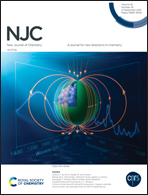A xanthene-based novel colorimetric and fluorometric chemosensor for the detection of hydrazine and its application in the bio-imaging of live cells†
Abstract
Efficient reactive fluorescent chemosensors are generating considerable attention for analyte detection due to easy instrumentation, low cost and quick response. Hydrazine is a reactive chemical substance to the industry and is toxic to human health. Herein, an ICT-based hydrazine-responsive chemodosimeter 2-{(7,8-dihydro-3-methoxy-6H-xanthen-5-yl)methylene}-2H-indene-1,3-dione (MXI) sensor with high selectivity and quick response has been designed, synthesized and characterized. Upon treatment with hydrazine, the probe displays a distinct colour change to the naked eye, from violet to colourless in DMSO aqueous solution and a turn-on fluorescent signal is achieved. DFT calculations reveal that the hypsochromic shift in absorbance spectra and fluorescent enhancement was due to ICT (intramolecular charge transfer) blocking upon reaction with hydrazine and the probe. By its successful demonstrations in real-time test kit sensing, this probe overcomes most of the drawbacks of the fluorescent probes of recent times. Furthermore, this probe has also been effectively utilized for imaging intracellular hydrazine in human bone osteosarcoma (MG63) cells.



 Please wait while we load your content...
Please wait while we load your content...